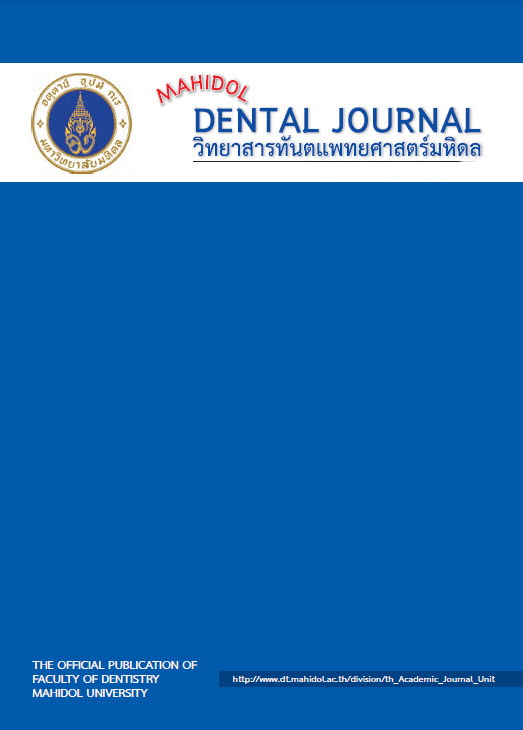Effect of surface sealant coating on flexural strength of provisional resin materials
Main Article Content
Abstract
Objective To investigate the effect of surface sealant coating on flexural strength of four provisional resin materials used for fixed partial prosthesis.
Materials and Methods The total of one hundred and twenty-eight bar-shaped specimens (25 mm ×2 mm× 2 mm) were fabricated from four provisional restorative materials according to manufacturer’s instruction: methacrylate resin (Unifast Trad) and bis-acryl resins (Protemp 4, Luxatemp Fluorescence and Integrity). The prepared specimens were wet polished with 320-grit silicon carbide abrasive paper. The specimens of each material were then randomly assigned into 2 groups; group 1: non-sealant group (n=16) as a control group and group 2: sealant group (n=16). For group 1, the specimens were immersed in 37oC distilled water for 24 hours. For group 2, the specimens were sandblasted with 50 micron-aluminium oxide, rinsed with water and dried. Then the surface sealant agent (Optiglaze color) was applied on the specimens’ surface and the specimens were immersed in 37oC distilled water for 24 hours. After both groups were stored in distilled water for 24 hours, the three-point flexural strength test by a universal testing machine (EZ-S, SHIMADZU, Japan) with a cross-head speed of 1±0.3 mm/min was performed and the data were analyzed by using a two-way analysis of variance.
Results In non-sealant group, the mean flexural strength of Unifast Trad, Protemp 4, Luxatemp fluorescence and Integrity were 63.45, 66.94, 71.64 and 76.18 MPa, respectively. Flexural strength of all bis-acryl resins was higher than methacrylate resins except Protemp 4, which was not statistically different from GC Unifast Trad (p>0.05). In sealant group, the mean flexural strength of Unifast Trad, Protemp 4, Luxatemp fluorescence and Integrity with surface sealant agent were 57.87, 72.51, 71.86 and 62.19 MPa, respectively. The mean flexural strength of Integrity and Luxatemp fluorescence in non-sealant group were statistically significant higher than Protemp 4 and GC Unifast (p<0.05). The mean flexural strength of Integrity and GC Unifast Trad in sealant group were statistically lower than non-sealant group (p<0.05). The mean flexural strength of Protemp 4 in sealant group were statistically higher than non-sealant group (p<0.05). The mean flexural strength of Luxatemp fluorescence in sealant group were not statistically difference from non-sealant group (p>0.05).
Conclusion The application of surface sealant did not increase the flexural strength of GC Unifast Trad, Integrity and Luxatemp fluorescence but it could improve the flexural strength of Protemp 4.
Article Details
References
2. Anusavice KJ, Shen C, Rawls R. Phillips' science of dental materials. 12th ed. St.Louis: Mosby; 2013.
3 Borchers L, Tavassol F, Tschernitschek H. Surface quality achieved by polishing and by varnishing of temporary crown and fixed partial denture resins. J Prosthet Dent 1999; 82: 550-56.
4 Dede DO, Sahin O, Koroglu A, Yilmaz B. Effect of sealant agents on the color stability and surface roughness of nanohybrid composite resins. J Prosthet Dent 2016; 116: 119-28.
5. ISO 10477. Dentistry - Polymer-based crown and bridge materials. International Organization for Standardization. 2004.
6. Lang R, Rosentritt M, Behr M, Handel G. Fracture resistance of PMMA and resin matrix composite-based interim FPD materials. Int J Prosthodont 2003; 16: 381-84.
7. Haselton DR, Diaz-Arnold AM, Vargas MA. Flexural strength of provisional crown and fixed partial denture resins. J Prosthet Dent 2002; 87: 225-28.
8. Nejatidanesh F, Momeni G, Savabi O. Flexural strength of interim resin materials for fixed prosthodontics. J Prosthodont 2009; 18: 507-11.
9. Young HM, Smith CT, Morton D. Comparative in vitro evaluation of two provisional restorative materials. J Prosthet Dent 2001; 85: 129-32.
10. Mei ML, So SYC, Li H, Chu CH. Effect of heat treatment on the physical properties of provisional crowns during polymerization: An in vitro study. Materials 2015; 8: 1766-77.
11. McKinny JE, Wu W. Relationship between sub- surface damage and wear of dental restorative composites. J Dent Res 1982; 61: 1083-88.
12. Wu W, Toth EE, Moffa JF, Ellison JA. Subsurface damage layer of in vivo worn dental composite restorations. J Dent Res 1984; 63: 675-80.
13. Ferracane JL, Condon JR, Mitchem JC. Evaluation of subsurface defects created
during the finishing of composites. J Dent Res 1992; 71: 1629-32.
14. Leinfelder KF, Wilder AD, Teixeira LC. Wear rates of posterior composite resins. J Am Dent Assoc 1990; 112. 251-55.
15. Braem M, Lambrechts P, Van Doren V, Vanherle G. In vivo evaluation of four posterior composites: Quantitative wear measurements and clinical behaviour. Dent Mater 1986; 2: 106-13.

